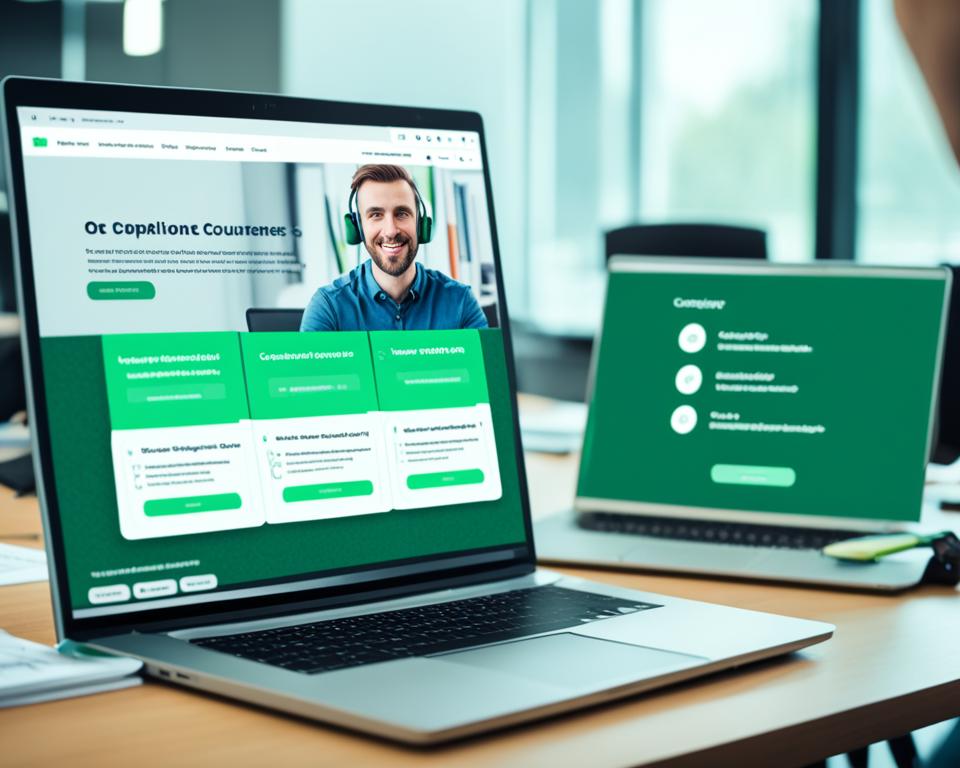Welcome to the step-by-step online learning guide for beginners! In today’s digital age, learning online has become more accessible than ever. Whether you want to develop new skills, pursue a passion, or enhance your career prospects, online learning offers a flexible and convenient way to achieve your goals.
Are you ready to dive into the world of online learning but not sure where to start? Don’t worry, we’ve got you covered. This comprehensive guide will take you through the essential steps needed to embark on your online learning journey with confidence.
From validating your course idea to creating engaging content, selecting the right platform, and effectively marketing your course, we’ll provide you with valuable insights and practical tips along the way. We’ll help you navigate through the process, ensuring a beginner-friendly learning experience from start to finish.
So, whether you’re interested in art, technology, business, or any other subject, join us on this exciting adventure and unlock your full potential through the power of online learning.
Key Takeaways:
- Step-by-step online learning is an ideal option for beginners looking to develop new skills or explore their interests.
- Validating your course idea ensures there is a demand for it, increasing your chances of success.
- Creating high-quality course content is crucial to engage learners and deliver a valuable learning experience.
- Choosing the right platform to sell your course enables you to reach your target audience effectively.
- Marketing your course effectively is essential to attract learners and maximize your earning potential.
Validating Your Course Idea
Before embarking on the creation of your online course, it is essential to validate your course idea to ensure there is demand in the market. By following a systematic approach to validating course ideas, you can confidently move forward with developing your online course, knowing that it will resonate with potential learners. This section will guide you through the step-by-step process of validating your course idea, including conducting thorough research, seeking valuable feedback, and creating a course prototype.
Conducting Course Idea Research
The first step in validating your course idea is conducting comprehensive research. This involves investigating the landscape of similar courses already available online, evaluating their demand, and identifying any gaps or opportunities for your course. Start by exploring popular online learning platforms, such as Udemy, Coursera, and Skillshare, and analyze the courses that are currently trending or have a high enrollment rate. Scrutinize course reviews and learner feedback to gain insights into what learners find valuable and what areas can be improved upon.
Additionally, you can use tools like Google Trends, keyword research tools, and social media listening to gauge the level of interest and demand for your course topic. By understanding the market demand and potential competition, you can refine your course idea to meet the needs and preferences of your target audience.
Seeking Feedback from Potential Learners
An essential aspect of validating your course idea is seeking feedback from your potential target audience. Engaging with potential learners allows you to gain valuable insights about their needs, preferences, and pain points. You can gather feedback through various means, such as surveys, interviews, or social media groups related to your course topic.
When seeking feedback, consider asking questions that help you evaluate the demand for your course idea. Inquire about the specific challenges learners face in the subject area, their motivation for taking an online course, and the aspects they would like to see in a course. This feedback will provide you with valuable guidance to refine and optimize your course content to meet the needs of your target audience.
Creating a Course Prototype
After conducting thorough research and gathering feedback, it’s time to create a course prototype. A course prototype is a condensed version of your course that showcases the core content and structure. It helps you validate your course concept by allowing potential learners to preview your course and provide feedback before its full development.
When creating a course prototype, focus on creating a representative sample of your content that provides a clear understanding of what learners can expect from the full course. This can include a few video lessons, lecture materials, quizzes, or interactive elements. Use tools such as PowerPoint, video editing software, or e-learning authoring tools to create visually engaging and interactive prototype materials.
Once you have created the course prototype, share it with a select group of potential learners and gather their feedback through surveys or interviews. Their input will help you improve and refine your course content before launching it to a wider audience.
By following the process of conducting research, seeking feedback, and creating a course prototype, you can validate your course idea and ensure that it meets the demands and expectations of potential learners. This validation process will provide you with confidence and insights to proceed with the development of your online course effectively.
Creating Course Content
Once you have validated your course idea, it’s time to start creating engaging and comprehensive content for your online course. This section will guide you through the process of organizing your course content, gathering existing resources, updating materials, and creating high-quality video content.
Organizing Your Course Content
Effective organization is key to delivering a seamless learning experience for your students. To ensure clarity and simplicity, consider the following steps:
- Create a logical and intuitive course structure that aligns with your learning objectives.
- Break the content into manageable modules or sections that build upon one another.
- Use headings, subheadings, and bullet points to make the content visually appealing and easily digestible.
- Provide clear instructions and learning outcomes for each module.
By organizing your course content thoughtfully, you can enhance your students’ learning experience and make it easier for them to navigate through the material.
Gathering Existing Resources
Utilize existing resources to enhance the quality and depth of your course content. Consider the following approaches:
- Research and include relevant articles, blog posts, and academic papers.
- Embed videos, podcasts, or interviews that provide additional insights.
- Curate relevant case studies or real-life examples to illustrate concepts.
- Include interactive elements such as quizzes, simulations, or exercises.
By leveraging existing resources, you can save time and provide your students with a well-rounded learning experience.
Updating Course Content
Regularly reviewing and updating your course content is essential to keep it relevant and up-to-date. Consider the following strategies:
- Stay informed about the latest industry trends and advancements.
- Incorporate new research findings or updated statistics.
- Address any feedback or suggestions from previous course participants.
- Revise and improve explanations or examples to enhance clarity.
By proactively updating your course content, you can ensure that your students receive the most current and valuable information.
Creating High-Quality Video Content
Video content is an effective way to engage your students and make complex concepts more easily understandable. Here are some tips for creating impactful videos:
“Video content is an effective way to visually explain concepts and engage students in your online course. It provides a more dynamic and interactive learning experience.”
- Invest in good quality audio and video equipment for clear and professional recordings.
- Write a script or outline to ensure a structured and coherent delivery.
- Use visuals, animations, or graphics to enhance understanding.
- Break longer videos into shorter segments to maintain engagement.
- Include closed captions or transcripts to cater to different learning styles.
Incorporating well-produced video content will elevate the overall quality of your course and keep your learners engaged.
Choosing the Right Format for Your Course
The format of your online course is a critical factor in engaging your learners and promoting effective learning outcomes. In this section, we will explore various course delivery models and help you select the best format for your target audience and learning objectives. We will delve into different options, including ad hoc online courses, multimedia course content, educational partnerships, flipped classrooms, and MOOCs (Massive Open Online Courses).
Ad Hoc Online Courses
An ad hoc online course is a flexible and customized learning experience that allows learners to choose specific modules or topics based on their interests or needs. This format is ideal for learners who prefer a more personalized approach and want to focus on specific areas of their expertise or curiosity.
Multimedia Course Content
Creating engaging and interactive multimedia course content can significantly enhance the learning experience. Incorporating videos, infographics, quizzes, and interactive elements can effectively keep learners engaged and facilitate better knowledge retention. By leveraging multimedia content, you can make your course more dynamic and appealing to different learning styles.
Educational Partnerships
Collaborating with educational institutions, industry experts, or subject matter specialists can provide additional credibility and expertise to your online course. By partnering with recognized organizations, you can tap into their resources, networks, and reputation to attract learners and enhance the overall learning experience.
Flipped Classrooms
Flipped classrooms involve reversing the traditional teaching model by delivering instructional content online before in-person or virtual class sessions. This format encourages learners to engage with the material independently and actively participate in collaborative learning activities during class time. By incorporating flipped classroom strategies, you can foster deeper understanding and meaningful interactions.
MOOCs (Massive Open Online Courses)
MOOCs are online courses that are designed to accommodate a large number of participants from diverse backgrounds. These courses typically offer free access to educational resources and encourage peer-to-peer collaboration. MOOCs can be an excellent option for reaching a broad audience, establishing your expertise, and fostering a global learning community.
Consider the unique needs of your target audience and the specific learning objectives of your course when choosing a format. Remember, there is no one-size-fits-all approach, and it may be beneficial to blend different formats or experiment with hybrid models to create an engaging and effective learning experience for your learners.
Selecting the Best Platform to Sell Your Course
Once your course content is ready, it’s time to choose the best platform to host and sell your online course. There are several options available, each with its own advantages and disadvantages. This section will compare selling courses on your own website to using a learning management system (LMS) or online marketplaces like Udemy and Coursera. We will provide reviews of different platforms to help you make an informed decision.
Selling Courses on Your Own Website
If you have a dedicated website for your online courses, selling courses directly through your site can offer greater control and flexibility. Here are a few key advantages:
- You can customize the look and feel of your course site to align with your brand.
- You have full control over pricing, payment options, and course delivery.
- You can build a direct relationship with your learners and have access to their contact information for future promotions.
Selling courses on your own website, however, does come with some challenges:
- You are responsible for driving traffic to your website and marketing your courses effectively.
- Setting up and maintaining your own course delivery and payment systems requires technical expertise.
- Establishing trust and credibility may be more challenging compared to established online marketplaces.
Using a Learning Management System (LMS)
An LMS is a software platform designed specifically for hosting and delivering online courses. It provides a comprehensive set of tools and features to manage and sell your courses. Here are some benefits of using an LMS:
- LMS platforms offer pre-built course templates and a user-friendly interface, making it easy to create and organize your course content.
- They provide integrated payment gateways and secure course delivery options.
- LMS platforms often have built-in marketing features, such as email automation and affiliate programs, to help you promote and sell your courses.
However, there are a few considerations when using an LMS:
- You may have limited control over the branding and customization of your course platform.
- Some LMS platforms charge transaction fees or have monthly subscription costs.
- Choosing the right LMS that aligns with your specific needs and budget requires research and evaluation.
Online Marketplaces
Online marketplaces like Udemy and Coursera provide a ready-made platform for selling and reaching a large audience. Here are some advantages of using online marketplaces:
- They have established user bases and a broad reach, potentially exposing your courses to a larger audience.
- Marketing and promotion efforts are shared with the marketplace, potentially reducing your personal marketing burden.
- Some marketplaces provide tools for course creation, marketing support, and customer service.
However, there are a few considerations when using online marketplaces:
- You may have limited control over pricing and course delivery options.
- Marketplaces often charge a percentage of your course sales as a commission fee.
- Choosing the right marketplace that aligns with your course content, target audience, and revenue goals is crucial.
Ultimately, choosing the best platform to sell your online course depends on your specific needs, resources, and goals as an online course creator. Consider the level of control, customization, and marketing support you require, as well as the target audience you want to reach. Research and compare different platforms based on their features, pricing, and user reviews to make an informed decision that sets you up for success.

Pricing Your Course
Pricing your online course is a crucial decision that can significantly impact your earning potential. It’s essential to find the right balance that attracts learners while ensuring you receive fair compensation for your expertise. In this section, we will explore different pricing strategies and factors to consider when determining the price for your online course.
Value-Based Pricing
One effective pricing strategy for online courses is value-based pricing. Instead of solely considering the time and effort you put into creating the course, value-based pricing focuses on the perceived value it offers to learners. Consider the unique knowledge and skills you are sharing, the transformation you promise, and the outcomes learners can achieve through your course. By pricing your course based on the value it provides, you can establish a fair price that resonates with your target audience.
Pricing Factors to Consider
When setting the price for your online course, several factors come into play. It’s crucial to consider these factors to ensure your pricing strategy aligns with your goals and the market demand:
- Course Content and Quality: The depth, relevance, and quality of your course content can influence its perceived value and, consequently, the price you can charge.
- Market Competition: Research the prices of similar courses in your niche and consider how your offering compares. While you should avoid competing solely on price, it’s essential to be aware of the market landscape.
- Target Audience: Understanding your target audience’s willingness to pay and their perceived value of your course can guide your pricing decisions.
- Earning Potential: Consider the number of potential learners and the revenue you aim to generate when setting the price. Balancing affordability and profitability is key.
Competing on Value, Not Price
While it might be tempting to compete solely on price to attract more learners, it’s important to focus on delivering value instead. Competing on price alone can devalue your course and compromise your earning potential. Instead, emphasize the unique value proposition of your course, such as your expertise, comprehensive curriculum, interactive elements, or additional resources. By differentiating yourself through value, you can attract learners who understand and appreciate the benefits of investing in a high-quality online learning experience.
Remember, delivering value means understanding and meeting the needs of your target audience effectively. By consistently providing valuable content and personalized support, you can build a reputation as a trusted and reputable online course provider.
| Strategy | Description | Advantages | Disadvantages |
|---|---|---|---|
| Value-Based Pricing | Setting prices based on the perceived value and benefits your course offers to learners. | – Places emphasis on the value provided – Can result in increased profit margins – Appeals to learners seeking high-quality content |
– Requires proper communication of value – May result in higher price points |
| Competitive Pricing | Setting prices based on the level of competition in your market. | – Can help establish a competitive edge – Attract price-sensitive learners |
– Potential profitability challenges – May lead to price wars and devaluation of your course |
| Penetration Pricing | Setting lower prices initially to attract a larger volume of learners and establish a foothold in the market. | – Builds a student base quickly – Increases brand awareness – Encourages word-of-mouth referrals |
– May not be sustainable in the long term – Potential revenue limitations |
| Bundling Pricing | Offering multiple courses or additional resources as a package deal at a discounted price. | – Provides added value to learners – Increases average order value – Encourages cross-selling |
– Requires additional course development – May confuse learners with too many options |
Marketing Your Course
After setting up and pricing your course, it’s time to focus on marketing to attract learners. Building an online presence through effective marketing strategies is key to reaching your target audience. This section will provide you with valuable insights on how to promote your course and maximize its visibility.
Building Your Online Presence
In order to market your course successfully, it’s important to establish a strong online presence. Here are some strategies to consider:
- Create a professional website or landing page where potential learners can find information about your course.
- Optimize your website for search engines to improve its visibility in search results.
- Utilize social media platforms such as Facebook, Twitter, and LinkedIn to engage with your target audience and promote your course.
- Collaborate with influencers or industry experts who can endorse your course and reach a wider audience.
Creating Effective Marketing Materials
Compelling marketing materials can help you effectively communicate the value of your course. Consider the following tips:
- Create a captivating course trailer or promotional video that highlights the key features and benefits of your course.
- Design visually appealing graphics and banners to use on your website and social media channels.
- Write persuasive copy and compelling headlines that grab the attention of potential learners.
- Include testimonials or success stories from previous learners to build trust and credibility.
Utilizing Social Media and Other Platforms
Social media and other online platforms can be powerful tools for promoting your course. Here’s how to make the most of them:
- Identify the platforms that are most popular among your target audience and focus your efforts there.
- Create engaging and shareable content that provides value to your audience.
- Run targeted ads on social media platforms to reach a wider audience.
- Join relevant online communities or forums where you can connect with potential learners and share insights related to your course.
Repurposing Content and Creating a Community
Repurposing your course content and creating a community around your courses can enhance engagement and help promote your course further. Here are some ideas:
- Repurpose your course content into blog posts, infographics, or podcasts to reach a broader audience.
- Encourage learners to share their experiences and insights on social media or through content creation contests.
- Create a private online community or forum where learners can interact with each other and with you as the course instructor.

| Strategy | Description |
|---|---|
| Building Your Online Presence | Establish a professional website, optimize for search engines, utilize social media, collaborate with influencers. |
| Creating Effective Marketing Materials | Create a course trailer, design visually appealing graphics, write persuasive copy, include testimonials. |
| Utilizing Social Media and Other Platforms | Identify popular platforms, create engaging content, run targeted ads, join online communities. |
| Repurposing Content and Creating a Community | Repurpose content into different formats, encourage learner engagement, create online communities or forums. |
Measuring Course Engagement
Once learners start enrolling in your course, it’s crucial to track their progress and measure engagement metrics. This allows you to assess the effectiveness of your course content and make improvements to enhance the learning experience. By monitoring course metrics, gathering learner feedback, and measuring learner progress, you can continuously refine your course and maximize its impact.
Tracking Course Metrics
Tracking course metrics provides valuable insights into how learners are interacting with your course. It allows you to understand which sections or modules are most popular, which activities are leading to the highest engagement, and the overall performance of your course. By using learning management system (LMS) analytics or third-party tracking tools, you can collect data on metrics such as:
- Number of enrollments
- Completion rates
- Average time spent per module
- Quiz or assessment scores
- Progress through the course
With this information, you can identify areas of your course that may require improvement and make data-driven decisions to optimize the learning journey.
Course Evaluation and Learner Feedback
In addition to tracking metrics, conducting course evaluations and gathering learner feedback provides valuable qualitative insights into the effectiveness of your course. Encourage learners to provide feedback through surveys, assessments, or discussion forums. This feedback can help you understand learners’ satisfaction levels, identify areas where they are struggling, and gather suggestions for improvement.
“The beauty of feedback is that it starts a conversation between the teacher and the learner, leading to a collaborative learning experience.”
Analyze the feedback and identify recurring themes or patterns. Use this feedback to address any issues, improve course content, and enhance the overall learning experience.
Measuring Learner Progress
Measuring learner progress is essential to ensure that your course is delivering the intended learning outcomes. Use formative assessments throughout the course to gauge learners’ understanding of the content. This can be in the form of quizzes, assignments, or interactive activities. By monitoring learner performance, you can identify knowledge gaps and provide targeted support or additional resources to help learners succeed.
Continuously measuring learner progress allows you to adapt your teaching methods and modify course content to address learners’ needs. It also helps you identify high-performing learners who may benefit from additional challenges or advanced materials.
Remember, tracking course metrics, gathering feedback, and measuring learner progress are ongoing processes. Regularly assess and analyze the data to make informed decisions and improve your course content. By leveraging these insights, you can create a more engaging and impactful learning experience for your students.
Establishing Credibility as a Teacher
Building credibility as an online teacher is paramount in attracting and retaining learners. This section will explore various strategies to establish credibility and build trust with your audience. By obtaining relevant online teacher certifications, showcasing your expertise in your field of teaching, and leveraging testimonials and reviews from satisfied learners, you can solidify your position as an authority. This will not only enhance your credibility but also attract more students to enroll in your courses.
Obtaining Online Teacher Certifications
Earning online teacher certifications can significantly contribute to establishing your credibility in the online teaching realm. These certifications demonstrate your commitment to continuous professional development and showcase your competence in delivering effective online education. By acquiring certifications from recognized institutions or education platforms, you can gain a competitive edge and instill trust in potential learners.
Showcasing Your Expertise
Another effective way to build credibility is by showcasing your expertise in the subject matter you teach. Demonstrate your knowledge and experience through engaging content, thoughtful discussions, and practical examples. By consistently providing valuable insights and demonstrating your passion for the topic, learners will recognize you as a trusted authority in the field.
Leveraging Testimonials and Reviews
Testimonials and reviews from satisfied learners serve as powerful social proof and can significantly enhance your credibility. Encourage your students to share their positive experiences and feedback about your teaching methods, course content, and overall learning experience. Display these testimonials prominently on your website or course platform to showcase the value and impact of your teaching.
“[Your Name]’s online course has transformed my understanding of [subject]. The content was comprehensive, well-structured, and taught in a way that made complex concepts easy to grasp. I highly recommend [Your Name] as a knowledgeable and engaging online teacher.” – [Learner’s Name]
“I enrolled in [Your Name]’s online course hoping to improve my skills in [subject]. Through [Your Name]’s expert guidance and engaging teaching style, I not only gained a deeper understanding of the subject but also found inspiration for further exploration. [Your Name] is a true expert in their field.” – [Learner’s Name]
Enhancing Credibility Through a Strong Online Presence
Building a strong online presence can further establish your credibility as an online teacher. By actively engaging with your audience through blog posts, social media platforms, and participation in relevant forums and discussions, you can create a professional online persona. Consistently sharing valuable insights, tips, and resources will help validate your expertise and attract potential learners to your courses.
Establishing credibility as an online teacher is an ongoing process that requires dedication and a commitment to delivering exceptional educational experiences. By obtaining relevant certifications, showcasing expertise, and leveraging testimonials and reviews, you can build a strong reputation as an authority in your field and create a loyal community of learners who trust your teaching abilities and value your expertise.
Planning Your Online Learning Journey
Embarking on an online learning journey requires careful planning and preparation. Creating an effective working environment, maintaining regular communication with learners, and implementing motivation strategies are key factors for success. In this section, we will provide you with tips and best practices to help you plan your online learning journey.
Creating a Conducive Working Environment
To optimize your learning experience, it’s essential to create a conducive working environment. Find a quiet space that allows you to focus and minimize distractions. Ensure your workspace is comfortable, well-lit, and organized. Eliminate clutter, as a clean and organized space promotes better concentration and productivity. Keep all necessary learning materials within reach, such as textbooks, notebooks, and a reliable internet connection.
Maintaining Regular Communication with Learners
Communication plays a vital role in online learning. Regular, clear, and timely communication with learners fosters engagement and ensures that students feel supported throughout the course. Respond promptly to messages, questions, and concerns from your learners. Encourage open and respectful discussions, both one-on-one and in group settings. Provide guidance and feedback to help learners stay on track and address any challenges they may encounter. Utilize various communication channels, such as email, discussion forums, and video conferences, to accommodate different learning preferences and schedules.
Implementing Motivation Strategies
Motivation is crucial for maintaining learner engagement and progress. Implement strategies to keep your learners motivated throughout the course. Set realistic goals and provide clear objectives for each lesson or module. Celebrate milestones and achievements to encourage a sense of accomplishment. Incorporate interactive activities, quizzes, and assessments to create a sense of progress and reward. Provide timely feedback to acknowledge learners’ efforts and guide their improvement. Encourage self-reflection and offer personalized support to help learners overcome obstacles and stay motivated.
By creating a conducive working environment, maintaining regular communication with learners, and implementing effective motivation strategies, you can ensure a fulfilling and successful online learning journey.
Choosing the Right Method of Teaching Online
When it comes to teaching online, there are various methods you can use to deliver your course content. The choice of method depends on your teaching style and the preferences of your target audience. In this section, we will explore different online teaching methods and help you determine the right approach for your course.
Live Lectures: Engage Your Students in Real-Time
Live lectures allow you to connect with your students in real-time, just like in a traditional classroom setting. Through video conferencing tools, you can deliver your lectures, answer questions, and engage in interactive discussions with your students. This method provides a sense of immediacy and allows for direct student-teacher interaction. Live lectures work well for subjects that require real-time explanations and discussions.
Prerecorded Videos: Flexible Learning at Your Students’ Pace
Prerecorded videos provide flexibility for both you and your students. You can record your lectures in advance, allowing students to access the content at their own pace. This method is suitable for subjects that can be effectively taught through pre-recorded materials, such as demonstrations, tutorials, or lectures that do not require real-time interaction. Prerecorded videos allow students to revisit the content and learn at their preferred time and place.
Interactive Elements: Enhancing Engagement and Learning
Integrating interactive elements, such as quizzes, assessments, and interactive multimedia, can enhance student engagement and learning outcomes. By incorporating interactive activities into your course, you provide opportunities for students to apply their knowledge, receive immediate feedback, and actively participate in the learning process. Interactive elements can be used in combination with live lectures or prerecorded videos to create an engaging and interactive learning experience.
Individual vs. Cohort Learning: Tailoring to Different Needs
When teaching online, you have the flexibility to offer individual or cohort learning experiences. Individual learning allows students to progress at their own pace and receive personalized attention. Cohort learning, on the other hand, brings students together in a community, fostering collaboration, peer learning, and networking opportunities. The choice between individual and cohort learning depends on the nature of your course and the learning objectives you want to achieve.
| Online Teaching Methods | Advantages | Disadvantages |
|---|---|---|
| Live Lectures | – Real-time interaction with students – Immediate feedback – Sense of community |
– Limited flexibility in scheduling – Technical difficulties |
| Prerecorded Videos | – Flexibility for students – Revisit content anytime – Self-paced learning |
– Lack of real-time interaction – Less immediate feedback |
| Interactive Elements | – Increased student engagement – Active learning – Application of knowledge |
– Requires additional development time – Technical implementation challenges |
| Individual Learning | – Personalized attention – Self-paced learning – Tailored feedback |
– Limited opportunities for collaboration – Less peer interaction |
| Cohort Learning | – Collaboration opportunities – Peer learning – Networking |
– Group dynamics challenges – Potential schedule conflicts |
Conclusion
Starting an online learning journey as a beginner may seem daunting, but with a step-by-step guide and the right strategies in place, you can create and sell your own online course successfully. By validating your course idea, creating compelling content, choosing the right platform, and implementing effective marketing tactics, you can embark on a rewarding journey of teaching and learning online.
First and foremost, validating your course idea is crucial to ensure there is demand for your chosen topic. Conduct thorough research and seek feedback from potential learners to refine your course content and meet their needs. Creating engaging and comprehensive content is the key to keeping your learners motivated and satisfied.
In addition, selecting the best platform to host and sell your course is essential. Consider factors such as ease of use, marketing support, and the platform’s target audience to make an informed decision. Furthermore, marketing your course and building your online presence will help attract potential learners and generate interest in your offering.
Remember, establishing credibility as a teacher by obtaining relevant certifications and leveraging testimonials and reviews will enhance your reputation and attract more students to your courses. Lastly, planning your online learning journey and choosing the right teaching methods will contribute to a positive and personalized learning experience for your students.
tag for FAQ and tag for the questions.
How can I validate my course idea?
To validate your course idea, you can conduct research to understand the demand for your topic, seek feedback from potential learners, and create a course prototype to test its viability.
How do I create compelling course content?
To create compelling course content, you can gather existing resources, organize your content in a logical manner, update any outdated materials, create high-quality video content, and conduct a comprehensive walkthrough of your course using tools like ScreenFlow.
What format should I choose for my online course?
Choosing the right format depends on your target audience and learning objectives. You can consider ad hoc online courses, multimedia course content, educational partnerships, flipped classrooms, or MOOCs to deliver your course effectively.
What is the best platform to host and sell my online course?
The best platform for hosting and selling your online course depends on your specific needs. You can compare the advantages and disadvantages of selling courses on your own website versus using a learning management system (LMS) or online marketplaces like Udemy and Coursera to make an informed decision.
How should I price my online course?
Pricing your online course involves considering factors like the value it provides, your competition, and your earning potential. It’s important to focus on delivering value to your learners rather than solely competing based on price.
How can I effectively market my online course?
To effectively market your online course, you can build an online presence, create compelling marketing materials, utilize social media and other platforms, repurpose your content, and create a community around your courses to enhance engagement.
How do I measure learner engagement in my course?
To measure learner engagement in your course, you can track course metrics, gather learner feedback, continuously improve your course based on insights, and measure learner progress. This will help you enhance the overall learning experience.
How can I establish credibility as an online teacher?
To establish credibility as an online teacher, you can obtain relevant certifications, showcase your expertise, and leverage testimonials and reviews from satisfied learners, gaining trust and attracting more students to your courses.
What are some tips for planning my online learning journey?
Some tips for planning your online learning journey include creating an effective working environment, maintaining regular communication with your learners, clarifying expectations, and implementing strategies to keep them motivated throughout the course.
What is the best method of teaching online?
The best method of teaching online varies based on your teaching style and the preferences of your target audience. You can choose from live lectures, prerecorded videos, interactive elements, and create a personalized learning experience for your students.
Without conclusion, just





